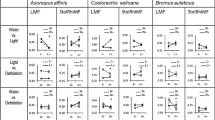Summary
Eleven grass species varying in potential relative growth rate (RGR) were investigated for differences in chemical composition by pyrolysis mass spectrometry. The spectral data revealed correlations between RGR and the relative composition of several biopolymers. Species with a low potential RGR contained relatively more cell wall material such as lignin, hemicellulose, cellulose, polysaccharide-bound ferulic acid and hydroxyproline-rich protein, whereas species with a high potential RGR showed relatively more cytoplasmic elements such as protein (other than those incorporated in cell walls) and sterols.
Similar content being viewed by others
References
Bastide P, Massonie G, Macheix J-J (1988) Influence in vitro des composés phénoliques des jeunes filles du pêcher, Prunus persica (L.) Batsch, sur le puceron vert du pêcher, Myzus persicae Sulzer. Agronomie 8:787–792
Boon JJ (1989) An introduction to pyrolysis mass spectrometry of lignocellulosic material: case studies on barley straw, corn stem and Agropyron. In: Chesson A, Ørskov ER (eds), Physicochemical characterization of plant residues for industrial and feed use. Elsevier Applied Science, Amsterdam, pp 25–45
Boon JJ, Tom A, Brandt B, Eijkel GB, Kistemaker PG, Notten FJW, Mikx FHM (1984) Mass spectrometric and factor discriminant analysis of complex organic matter from the bacterial culture environment of Bacteroides gingivalis. Anal Chim Acta 163:193–205
Classen D, Arnason JT, Serratos JA, Lambert JDH, Nozzolillo C, Philogene BJR (1990) Correlation of phenolic acid content of maize to resistance to Sitophilus zeamais, the maize weevil, in cimmyt's collections. J Chem Ecol 16:301–315
Dijkstra P, Lambers H (1989) A physiological analysis of genetic variation in relative growth rate within Plantago major L. Funct Ecol 3:577–587
Glazener JA (1980) Defense mechanism in tomato fruit after infection with Botrytis cinerea. Thesis, Utrecht University
Grime JP, Hunt R (1975) Relative growth-rate: its range and adaptive significance in a local flora. J Ecol 63:393–422
Harris PJ, Hartley RD (1980) Phenolic constituents of the cell wall of monocotyledons. Biochem Syst Ecol 8:153–160
Hartley RD, Jones EC (1978) Phenolic components and degradability of the cell walls of the brown midrib mutant, bm 3 , of Zea mays. J Sci Food Agric 29:777–789
Ismail MK, Salama A-AM, Ali MIA, Ouf SA-E (1987) Effect of some phenolic compounds on spore germination and germ-tube length of Aspergillus fumigatus and Fusarium oxysporum f.sp. lycopersici. Crytogamie-Mycologie 8:51–60
Kephart KD, Buxton DR, Hill RR Jr, (1990) Digestibility and cell wall components of alfalfa selected for divergent herbage lignin concentration. Crop Sci 30:207–212
Kokubu A, Kuraishi S, Sakurai N (1990) Culm strength of barley. Correlations among maximum bending stress, cell wall dimensions and cellulose content. Plant Physiol 91:876–882
Kratka J (1989) Changes of hydroxyproline content in the cell wall of carnation after inoculation with Fusarium oxysporum f.sp. dianthi. Zentralbe Mikrobiol 144:485–488
Kuc J, Henze RE, Ullstrup AJ, Quackenbush FW (1956) Chlorogenic and caffeic acids as fungistatic agents produced by potatoes in response to inoculation with Helminthosporium carbonum. J Am Chem Soc 78:3128–3125
Lambers H, Dijkstra P (1987) A physiological analysis of genotypic variation in relative growth rate: Can growth rate confer ecological advantage? In: van Andel J, Bakker JP, Snaydon RW (eds) Disturbance in Grasslands. Junk, Dordrecht, pp 237–252
Lambers H, Poorter H (1992) Inherent variation in growth rate between higher plants: A search for physiological causes and ecological consequences. Adv Ecol Research 22: in press
Marcus A, Greenberg J, Averyhurt-Fullard V (1991) Repetitive proline-rich proteins in the extracellular matrix of the plant cell. Physiol Plant 81:273–279
Niemann GJ, Baayen RP (1988) Involvement of phenol metabolism in resistance of Dianthus caryophyllus to Fusarium oxysporum f.sp. dianthi. Neth J Plant Pathol 94:289–301
Niemann GJ, Baayen RP, Boon JJ (1990) Differentiation between tissues from carnation (Dianthus caryophyllus L.) stems by pyrolysis-mass spectrometry. Ann Bot 65:461–472
Poorter H (1989) Interspecific variation in relative growth rate: On ecological causes and physiological consequences. In: Lambers H, Cambridge ML, Konings H, Pons TL (eds) Causes and consequences of variation in grwoth rate and productivity in higher plants. SPB Academic Publishing, The Hague, pp 49–68
Poorter H, Bergkotte M (1992) Chemical composition of 24 wild species differing in relative growth rate. Plant Cell Environ, in press
Poorter H, Remkes C (1990) Leaf area ratio and net assimilation rate of 24 wild species differing in relative growth rate. Oecologia 83:553–559
Pouwels AD, Boon JJ (1990) Analysis of beech wood samples, its milled wood lignin and polysaccharide fractions by Curie-point and platinum filament pyrolysis-mass spectrometry. J Anal Appl Pyrolysis 17:97–126
Scheijen MA (1991) Analytical pyrolysis studies on Tobacco. Thesis, University of Amsterdam
Scheijen MA, Brandt-de Boer B, Boon JJ, Hass W, Heemann V (1989) Evaluation of a tobacco fractionation procedure using pyrolysis mass spectrometry combined with multivariate analysis. Beitr Tabakforsch 14:261–282
Van der Heijden E, Boon JJ, Scheijen MA (1990) Pyrolysis mass spectrometric mapping of selected peats and peatified plant tissues. In: Sopo R (ed) Peat 90. International conference on peat production and use, Vol 1. The Association of Finnish peat Industries, Jyska, pp 148–162
Waterman PG, McKey D (1989) Herbivory and secondary compounds in rain-forest plants. In: Lieth H, Werger UJA (eds) Tropical Rain Forest Ecosystems. Elsevier, Amsterdam, pp 513–536
Author information
Authors and Affiliations
Rights and permissions
About this article
Cite this article
Niemann, G.J., Pureveen, J.B.M., Eijkel, G.B. et al. Differences in relative growth rate in 11 grasses correlate with differences in chemical composition as determined by pyrolysis mass spectrometry. Oecologia 89, 567–573 (1992). https://doi.org/10.1007/BF00317165
Received:
Accepted:
Issue Date:
DOI: https://doi.org/10.1007/BF00317165




